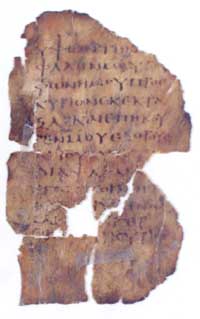|
Parchment is a specially treated form of leather that is soft and durable, making it an excellent writing material. High quality parchment is sometimes referred to as vellum. It is known that parchment was used as a writing material as early as the Ptolemaic era, and it was in fact preferred over papyrus in northern regions, where the climate can be unfavorable for papyrus, and also in Near Eastern regions. |
|
|
|
|
The two examples of parchment shown here are rather badly damaged. Notice how the ink on the Coptic manuscript (left) has begun to eat through the parchment, due to the acidity of the ink. While you can't tell it from the pictures, parchment is soft to touch, and the difference between the internal side and the external side can be noticed. On poorer quality pieces of parchment, traces of animal hair are sometimes left behind. After about the third century AD, papyrus began to be used less, and parchment was used more. Parchment had the advantage that it could be produced anywhere, while papyrus rolls could only be produced in the parts of Egypt where the papyrus plant grows. At about the same time, the roll began to be replaced by the codex. In a codex, multiple pages of parchment (or papyrus) are bound together, much like a modern book. The example on the right is taken from a codex. |







